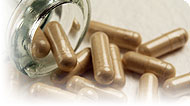Caprylic Acid
Uses
Caprylic acid is a saturated fatty acid containing eight carbon atoms, making it one of the family known as medium-chain fatty acids. Test tube and animal research has shown caprylic acid to have antibacterial,1 antiviral,2 and antifungal properties.3 Preliminary reports from the 1940s and 1950s indicated that caprylic acid may be effective against yeast (Candida) infections in humans.45
Our proprietary “Star-Rating” system was developed to help you easily understand the amount of scientific support behind each supplement in relation to a specific health condition. While there is no way to predict whether a vitamin, mineral, or herb will successfully treat or prevent associated health conditions, our unique ratings tell you how well these supplements are understood by the medical community, and whether studies have found them to be effective for other people.
For over a decade, our team has combed through thousands of research articles published in reputable journals. To help you make educated decisions, and to better understand controversial or confusing supplements, our medical experts have digested the science into these three easy-to-follow ratings. We hope this provides you with a helpful resource to make informed decisions towards your health and well-being.
3 StarsReliable and relatively consistent scientific data showing a substantial health benefit.
2 StarsContradictory, insufficient, or preliminary studies suggesting a health benefit or minimal health benefit.
1 StarFor an herb, supported by traditional use but minimal or no scientific evidence. For a supplement, little scientific support.
This supplement has been used in connection with the following health conditions:
| Used for | Why |
|---|---|
1 Star Chronic Candidiasis 500 to 1,000 mg three times a day | Based on some historical use and theoretical research, caprylic acid is sometimes recommended as a treatment for yeast. Test tube studies and case reports from the 1940s and 1950s indicated that caprylic acid (a naturally occurring fatty acid) was effective against yeast (Candida) infections of the intestines. However, these effects have not been studied or proven in controlled trials. Doctors sometimes recommend amounts of 500 to 1,000 mg three times a day. |
How It Works
How to Use It
Where to Find It
Possible Deficiencies
Interactions
Interactions with Supplements, Foods, & Other Compounds
Interactions with Medicines
Side Effects
Side Effects
References
1. Nair MK, Joy J, Vasudevan P, et al. Antibacterial effect of caprylic acid and monocaprylin on major bacterial mastitis pathogens. J Dairy Sci 2005;88:3488-95.
2. Isaacs CE, Litov R, Thormar H. Antimicrobial activity of lipids added to human milk, infant formula, and bovine milk. J Nutr Biochem 1995;6:362-6.
3. Liu S, Ruan W, Li J, et al. Biological control of phytopathogenic fungi by fatty acids. Mycopathologia 2008;166:93-102.
4. Keeney EL. Sodium caprylate: a new and effective treatment of moniliasis of the skin and mucous membrane. Bull Johns Hopkins Hosp 1946;78:333-9.
5. Neuhauser I, Gustus EL. Successful treatment of intestinal moniliasis with fatty acid resin complex. Arch Intern Med 1954;93:53-60.
6. Sills MA, Forsythe WI, Haidukewych D, et al. The medium chain trigylceride diet and intractable epilepsy. Arch Dis Child 1986;61:1168-72.
7. Nair MK, Joy J, Venkitanarayanan KS. Inactivation of Enterobacter sakazakii in reconstituted infant formula by monocaprylin. J Food Prot 2004;67:2815-9.
Last Review: 05-24-2015

Copyright © 2024 TraceGains, Inc. All rights reserved.
Learn more about TraceGains, the company.
The information presented by TraceGains is for informational purposes only. It is based on scientific studies (human, animal, or in vitro), clinical experience, or traditional usage as cited in each article. The results reported may not necessarily occur in all individuals. For many of the conditions discussed, treatment with prescription or over the counter medication is also available. Consult your doctor, practitioner, and/or pharmacist for any health problem and before using any supplements or before making any changes in prescribed medications. Information expires December 2024.
This information does not replace the advice of a doctor. Healthwise, Incorporated, disclaims any warranty or liability for your use of this information. Your use of this information means that you agree to the Terms of Use. Learn how we develop our content.

